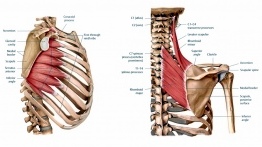Forearm plank is one of those poses that I will never stop teaching. It builds strength in all the right places once you are ready to tackle it. It is a core exercise but as I wrote in a post a couple of days ago it is easy to use the upper body to avoid using the core muscles that the pose can develop. That post was about using the pectoralis minor and major too much to avoid working the core. It also throws off the relationship between two other important upper trunk muscles.
Of the muscles that surround and encase the shoulder blades the Rhomboids have a particularly difficult job. They are largely responsible for the shoulder blades’ connection to the spine though the trapezius and the levator scapula also attach to the vertebral column
The rhomboids connect from the inner edge of the shoulder-blade to the spine. The serratus anterior originates from the first eight or nine ribs and runs behind the shoulder-blade to connect along the same inner edge of the shoulder-blade as the rhomboids. They both stabilize the shoulder-blade on the rib cage, with a little help from pectoralis minor, but work in opposition to each other as the rhomboids pull the shoulder blades towards the spine and the serratus anterior pulls the shoulder blades towards the front of the chest.
While it is fairly easy to pinpoint weak rhomboids as shoulder blades that move towards each other too quickly in forearm plank, the issue always includes the serratus anterior as in certain ways we can look at them as one continuous muscle.
Forearm plank is the best pose out there for developing the muscles that stabilize the shoulders on the back. Engaging the rhomboids to draw the shoulder blades parallel to each other, while using serratus to keep them from moving too close together, makes these muscles work to their design. The more advanced trick in the video of essentially doing spinal pushups in between the shoulder blades is something to shoot for in the long run.
Good posture requires balance across a great many muscle groups. Using poses like forearm plank to bring the rhomboids and serratus anterior into better balance is a great place to begin.
***

